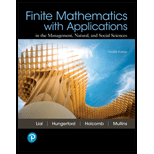
(a) First multiply both sides of
(b) First multiply both sides of
(c) First add
Want to see the full answer?
Check out a sample textbook solution
Chapter 2 Solutions
Finite Mathematics with Applications In the Management, Natural, and Social Sciences (12th Edition)
- i need help please hand writtenarrow_forwardneed help with part barrow_forwarddent Application X GA spinner is divided into five cox | + 9/26583471/4081d162951bfdf39e254aa2151384b7 A spinner is divided into five colored sections that are not of equal size: red, blue, green, yellow, and purple. The spinner is spun several times, and the results are recorded below: Spinner Results Color Frequency Red 5 Blue 11 Green 18 Yellow 5 Purple 7 Based on these results, express the probability that the next spin will land on purple as a fraction in simplest form. Answer Attempt 1 out of 2 Submit Answer 0 Feb 12 10:11 Oarrow_forward
- Question 4 Calculate the Moment about the point D in Nx m B 500 N A 2 m 300 N 10 E 1.2 m 0.5 m D 0.8 m 200 N Carrow_forwardQuestion 6 Calculate the Moment about the point C in Nx m B A 2 m 500 N 1.2 m 0.8 m 300 N C 7arrow_forwardQuestion 2 Calculate the Moment about the point A in Nx m B 500 N A 2 m 300 N 10 E 1.2 m 0.5 m D 0.8 m 200 N Carrow_forward
- Question 3 Calculate the Moment about the point B in Nxm A 300 N 2 m 500 N 4 B с 0.8 m 1.2 marrow_forwardQuestion 5 Calculate the Moment about the point B in Nx m B 500 N A 2 m 1.2 m 0.8 m 300 N 7arrow_forwardQuestion 1 Calculate the Moment about the point A in Nx m A 300 N 2 m 500 N 4 B C 0.8 m 1.2 marrow_forward
 Algebra: Structure And Method, Book 1AlgebraISBN:9780395977224Author:Richard G. Brown, Mary P. Dolciani, Robert H. Sorgenfrey, William L. ColePublisher:McDougal Littell
Algebra: Structure And Method, Book 1AlgebraISBN:9780395977224Author:Richard G. Brown, Mary P. Dolciani, Robert H. Sorgenfrey, William L. ColePublisher:McDougal Littell

 Elementary AlgebraAlgebraISBN:9780998625713Author:Lynn Marecek, MaryAnne Anthony-SmithPublisher:OpenStax - Rice University
Elementary AlgebraAlgebraISBN:9780998625713Author:Lynn Marecek, MaryAnne Anthony-SmithPublisher:OpenStax - Rice University Trigonometry (MindTap Course List)TrigonometryISBN:9781337278461Author:Ron LarsonPublisher:Cengage Learning
Trigonometry (MindTap Course List)TrigonometryISBN:9781337278461Author:Ron LarsonPublisher:Cengage Learning





